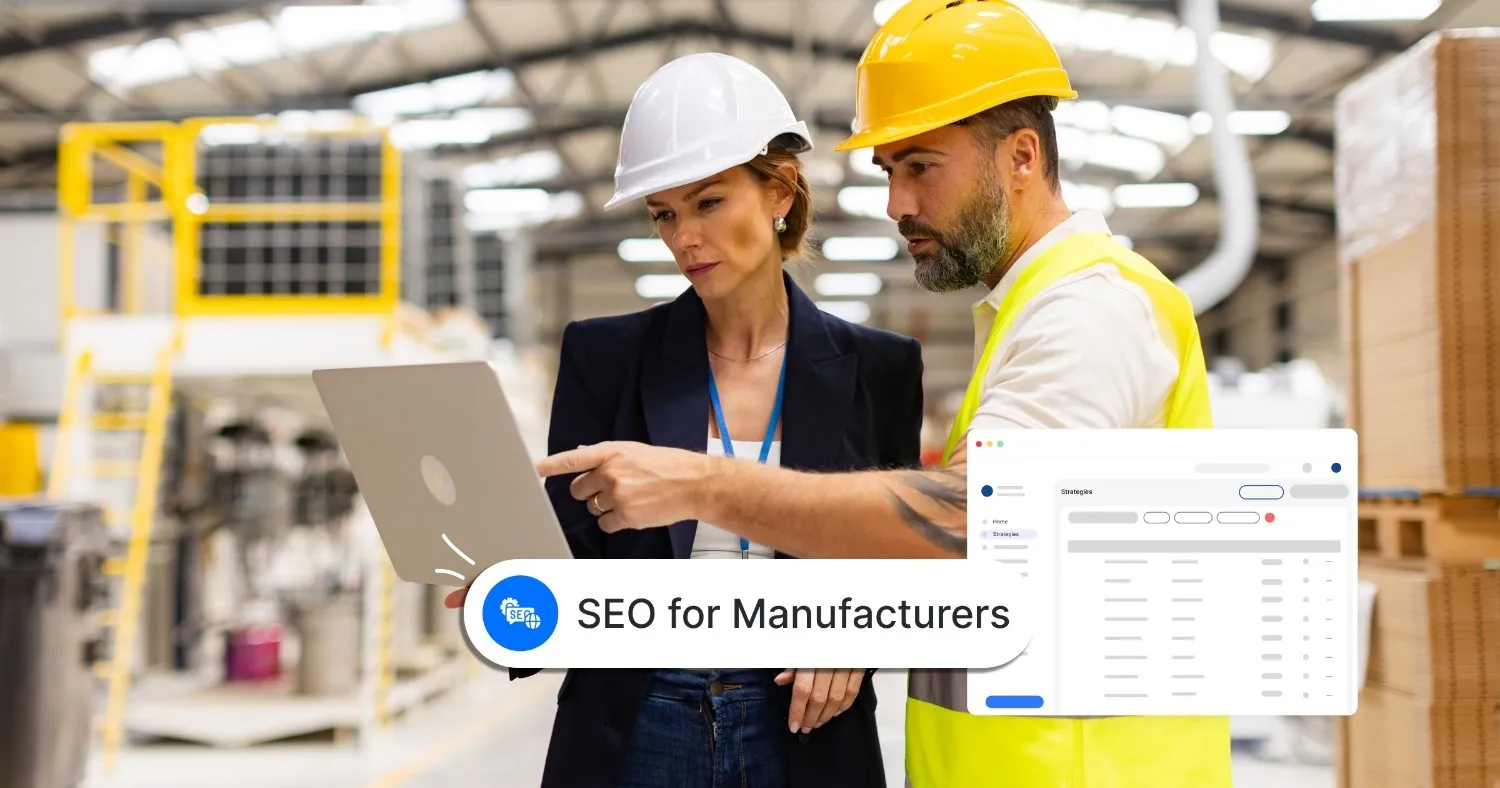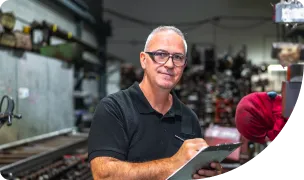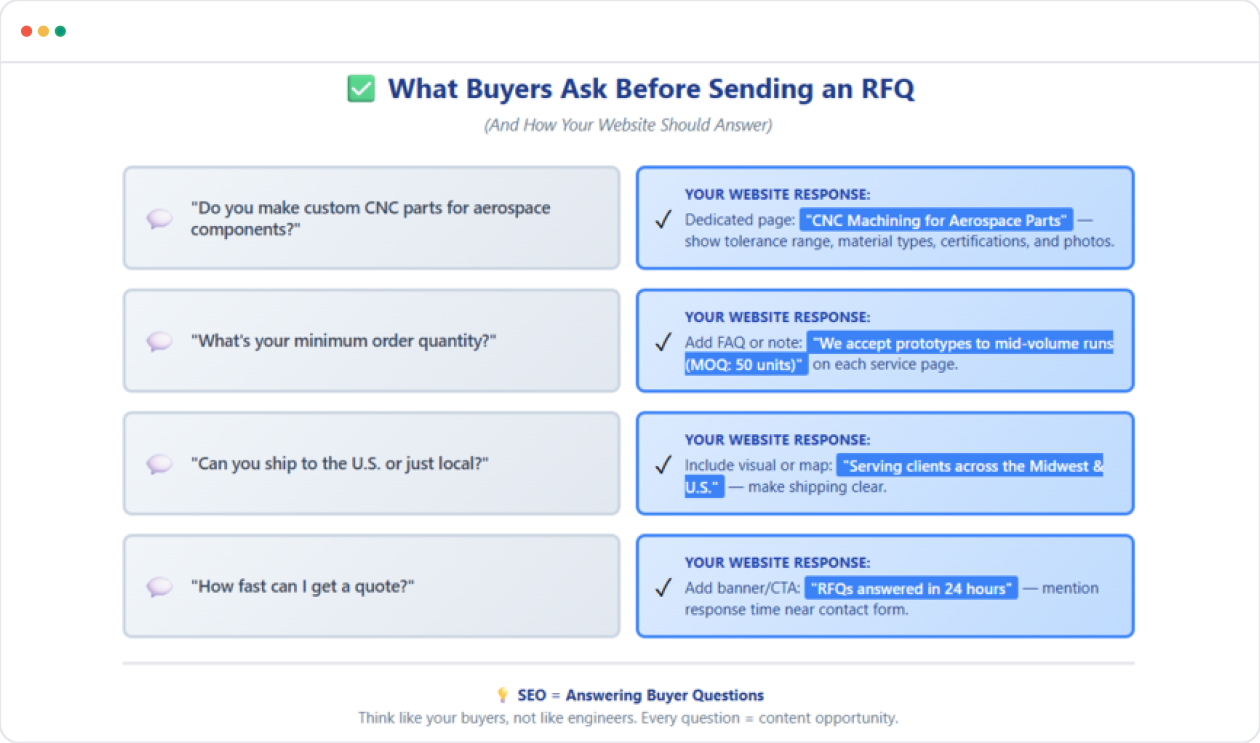Schedule a Call
Get started with your organic growth journey!




You might have the best machines on your industry floor, a solid team, and a reputation for quality work.
But if modern buyers can’t find you online, your competitors are getting the calls that should’ve come to you.
In today’s world, most customers start their search on Google.
If your company doesn’t show up there, it’s like having a great product locked inside a warehouse with no sign outside.
In short, being visible online means more people who need what you make can actually find you. And that can turn into more RFQs, faster.
Most manufacturers still rely on traditional outreach: trade shows, distributor networks, referrals, and word of mouth. These channels work, especially for long-term clients. But they’re slow, expensive, and hard to measure.
While your sales team spends hours chasing leads or attending expos, your potential buyers are already online, searching for suppliers, comparing capabilities, and checking certifications.
That’s the gap digital marketing fills.
Digital channels now make up about 75% of marketing budgets across all industries, including manufacturing. Digital marketing helps manufacturers get found when buyers are looking, not when you’re pitching. It’s measurable, scalable, and works 24/7, even when your sales team doesn’t.
At its core, digital marketing for manufacturers includes:
Among all these, SEO stands out because it builds long-term authority and credibility.
Unlike ads that stop when your budget does, SEO compounds — driving consistent leads month after month.

SEO (Search Engine Optimization) is simple, yet strategic. It’s a process of helping search engines like Google, Yahoo, Safari, or Bing understand what you do so it can show your business to the right people.
Think of it like this: If someone types “custom machining in Ohio,” Google decides which manufacturers deserve to appear first. SEO is how you make sure you’re that manufacturer.
SEO is like your digital trade show booth, open 24/7 and reaching buyers across the US (and even globally). Every search is a potential buyer walking down the aisle; the goal is to make sure they see your booth first.
Buyer searches on Google → Your site appears → They click on your website → You capture leads.
Watch this snippet to exactly know how manufacturers in the US are making $$$ of revenue using AI SEO agents.
Research shows that 57% of B2B companies say SEO brings in more leads than any other marketing channel.

It is mainly because it provides:
So, how do manufacturers actually achieve these results?
Think of SEO as two engines driving your digital visibility — one on your website, and one outside it. For industries, both are equally critical because your buyers evaluate you in two stages:
It comes down to two key parts of SEO working together: On-page SEO and Off-page SEO.
On-page SEO covers everything that lives on your website. It’s how you communicate your expertise, not just to potential buyers, but also to Google.
Here’s what to focus on:
Good on-page SEO ensures your site communicates value. When Google understands your expertise, it ranks you higher, helping buyers find you faster.
How it impacts your business: A well-optimized site keeps buyers engaged longer, leading to more quote requests and fewer lost opportunities.
Off-page SEO is everything that happens outside your website that boosts your credibility. It tells Google (and your prospects) that you’re trusted across the industry.
Here’s what to focus on:
Search engines view backlinks and brand mentions as proof of reliability. The more trusted websites vouch for you, the more confidence Google and your buyers will have in your business.
How it impacts your business: A strong off-page SEO profile helps your website rank for competitive industry keywords like custom injection molding or ISO-certified sheet metal fabrication.

When both on-page and off-page SEO work together, your website doesn’t just rank — it becomes a trusted website for buyers searching online.
Read More: 15+ Manufacturing SEO Companies for 2025-26
SEO takes time to work. It helps Google understand your website better and show it to the right buyers. Here’s how to make that compound over time:
Most manufacturing websites were built years ago and have never been touched since. But your homepage is the first thing buyers and Google look at; it’s your digital storefront.
If your site opens with “Welcome to ABC Manufacturing,” you’ve already lost them. Buyers (and Google) need clarity right away:
“Custom Automotive Parts Manufacturer | ISO-Certified Products in Michigan.”
That one line instantly tells both humans and search engines what you make and where you’re based.
Once that’s clear, make sure your website loads quickly, looks fine on mobile, and feels modern, because a slow, outdated site sends a signal that your business might be too.

In manufacturing, your buyers judge credibility fast. If your site loads slowly or looks broken on mobile, they won’t wait; they’ll find another supplier who looks more reliable online.
A slow website can also kill leads faster than poor pricing.
Use tools like Google Analytics or GTmetrix to check load times, mobile experience, and performance suggestions. Even a 1–2 second improvement in page load can keep buyers on your site longer and help you rank higher.
Google primarily uses your mobile site when determining rankings. That means your pages need to look and work perfectly on phones and tablets, not just desktops. If a buyer struggles to navigate your site on their phone, your ranking suffers, and so do your leads.
Earlier, we covered how on-page SEO helps Google and your buyers understand your website. This is where speaking your buyer’s language takes it to a level deeper. It’s about aligning your keywords with what real buyers actually search for.
Here’s where most manufacturers get it wrong.
You describe your services using technical or branded terms, “precision-engineered polymer solutions,” while your buyers search for “plastic injection molding company in Ohio.”
That’s a mismatch.
Do this quick exercise:
Why it works: Those buyer-used phrases are your most valuable keywords. They’re real, proven, and directly connected to purchase intent. Once you start using them naturally across your site, Google and buyers both recognize what you truly offer.
Don’t hide everything under a single “Services” tab. If you do CNC machining, sheet metal fabrication, or injection molding, each deserves its own page.
Why?
Because when a buyer searches for “CNC machining aerospace parts,” Google wants to send them to a page that proves you know that specific work, with specs, tolerances, certifications, and even a few photos or project highlights.
Use the Right Content to Show Expertise
Your pages don’t have to be just text.
Think of what buyers want to see: photos of past projects, short demo videos, team introductions, or case studies showing capabilities.
Blogs can answer common buyer questions. These content types not only help Google understand what you offer but also make buyers trust you more.

The more helpful and complete your pages are, the more Google trusts you.
You’ve probably seen marketing blogs talk about “backlinks.”
Backlinks simply mean other trusted sites mentioning or linking back to you, and Google takes that as proof you’re legitimate.
Backlinks aren’t the only credibility signal. Reviews on Google, industry directories, and even LinkedIn recommendations matter. Encourage satisfied clients to leave feedback. Positive reviews make your business more visible and trustworthy, which directly influences leads.
How Trustworthy Is Your Online Presence?
A few solid mentions on those sites can do more for your credibility than hundreds of random backlinks from unrelated sites.
Most buyers prefer working with manufacturers nearby. That’s why local SEO matters more than you’d think.
Beyond your Google Business Profile, ensure your company is listed consistently across industry directories like Thomasnet, MFG.com, or your local chamber of commerce. Keep your NAP (name, address, phone) identical everywhere.

You’re not just helping Google here. You’re helping the next buyer who wants to find someone like you but doesn’t know you exist yet.
SEO is not set-and-forget.
Use free tools like Google Search Console. It tells you what people searched before landing on your site, which pages get the most visits, and what’s leading to quote requests or calls.
SEO isn’t just about traffic on your website; it’s about real business results. Track which keywords bring visitors, which pages lead to RFQs, and how your visibility grows over time.
Even a small boost in leads can justify months of effort, and over time, SEO continues working—unlike paid ads that stop the moment you stop paying.
When you put all of this together (clarity, credibility, and consistency), SEO stops sounding too techy and becomes a lead engine.
What Success Should Look Like (Track These 3 KPIs)
You’re not trying to “beat the algorithm” here. You’re just explaining your work in a way Google understands and buyers can find.
Once your basics are in place, it’s time to step up your game. This is where a few advanced SEO moves can help you stay ahead of competitors and keep your rankings strong for years.
Once your basics are in place, your website is clear, fast, and showing up for the right searches, you can go one step further.
Now, schema markup sounds highly technical. But it isn’t too difficult for you to achieve. It is like adding labels and part numbers (basically, precise details) to your web pages.
“Think of Schema Markup as a Spec Sheet for Google.”
It tells Google exactly what your content is, whether it’s a product, service, or customer review.
For example, if you sell custom aluminum parts, you can add a “Product page with specs, pricing, capabilities, etc,” so Google knows that page shows a product, not just text.
When done right, this helps your pages appear with extra details, directly in search results. That means more visibility, more clicks, and more credibility.
Technical SEO Checklist
Make sure your site ticks all these boxes:
Run a free site check in minutes. See what’s slowing you down.
Once your website is technically sound, it’s time to see how you compare to yourself in the market.
Here’s where technology can actually save you time.
Instead of spending hours figuring out what to write or where your site is missing keywords, AI Agents (like Gushwork’s AI SEO) can analyze competitor websites, keywords your buyers are searching for, and page load time – all in minutes.

You don’t need to guess what to post; AI can help you decide what will actually bring more RFQs. It’s like having a digital analyst quietly map your entire market, showing you which areas to target so you can attract more RFQs without guesswork.
Once you know what buyers search for, it’s time to scale.
SEO takes time, but paid ads can give your website an instant visibility boost while your organic rankings build up. When used together, they make sure your brand shows up in both paid and organic search results — doubling your exposure to buyers.
Remember, paid ads work best when you already have some visibility and need to promote new launches or announcements.
Relying only on paid ads isn’t sustainable, they stop the moment you stop spending, while SEO continues to deliver leads long after.
Here’s how to do it right:
When your SEO, content, and paid ads start working together, you’ll notice your visibility improving and more qualified buyers visiting your site. Eventually, giving you leads.
Here’s the part every manufacturer wonders about: how long should I wait to see results?

Most manufacturers start seeing progress in 3–6 months. More pages, more visitors, more quote requests.
Remember, SEO compounds. Every update strengthens your authority, and the sooner you start, the sooner you pull ahead of competitors still waiting for referrals.
And here’s the best part: Most of your competitors aren’t doing this well yet. So if you start now and stay consistent, you could own your niche on Google before they even realize what happened.
Pro Tip: There are AI SEO Agents in the market that can do 6 months of content and SEO in just 4 weeks. Many manufacturers in the US already have found 30+ leads in 3-4 months using AI platforms.
Success in SEO isn’t just about doing more. It’s about doing it right. Many manufacturers unknowingly make small mistakes that undo months of progress.
Even experienced manufacturers who have tried SEO fall into a few traps. These aren’t technical errors that they make, but just blind spots that quietly block your visibility.
If you list all your capabilities (machining, molding, fabrication, finishing) on one page, Google can’t tell which one to show for a specific search.
So when someone searches “sheet metal fabrication Ohio,” you disappear.
Fix: Give each service its own page, with clear titles, specs, certifications, and even sample projects. It shows depth, and Google rewards expertise.
Most buyers prefer working with manufacturers nearby. But if your Google Business Profile (Your business listing on Google) is outdated or your address appears differently across directories, you’re invisible in local searches.
Fix: Keep your NAP (name, address, phone) consistent across your website, Google profile, and directories. Add phrases like “CNC machining in Michigan” naturally into the text on your website, especially on your homepage, service pages, and about section.
Many “SEO packages” promise hundreds of backlinks for cheap prices (Yes, you have to pay for other sites to link to your articles), but those links often come from spammy, irrelevant sites.
For manufacturers, it’s not about volume, it’s about authority.
Fix: Get listed on trusted industry platforms like Thomasnet, MFG.com, or your local chamber of commerce. One solid mention there can outweigh 50 low-quality links.
SEO isn’t a campaign you check off. It’s an ongoing part of how your business stays visible online. SEO takes time. It takes 6 months to 1 year to show real results. But it is sustainable and compounding. Once it starts showing results, it gives you leads for 2-3 years.
If you stop updating your pages, checking site speed, or publishing new capabilities, your rankings slowly slip.
Fix: Review your site quarterly. Check what’s ranking, what’s slow, and what’s outdated. Even minor improvements add up.

Avoiding these mistakes alone can put you ahead of 80% of your competitors. Most of whom are still treating SEO like an afterthought rather than an ongoing growth channel.

A manufacturing-tech exporter was stuck chasing customers. Then they flipped the script: 78 qualified RFQs in 12 months — zero ad spend.
They ranked in the top 3 for 250+ high-intent keywords, pulled in 12,700+ monthly visitors, and turned websites into lead machines.
Read more on how they did it...
1. Does SEO actually work for niche manufacturing companies?
Yes, even niche manufacturers can benefit from SEO. The key is identifying the right search phrases your buyers use (not your internal jargon) and optimising your site around them. Being one of the few in your niche with good visibility gives you a big advantage.
2. How long will it take to see leads from SEO for manufacturers?
For manufacturing companies, meaningful results typically begin in 3 to 6 months, assuming the basics (site clarity, keywords, content, links) are handled. Real lead generation often takes consistent effort beyond that; SEO compounds over time, so the longer you stay at it, the stronger your position becomes.
3. What kind of websites should link to mine for backlinks in manufacturing SEO?
Backlinks matter more than ever for manufacturing SEO strategy. Trusted industry-related sites such as Thomasnet, MFG.com, or industry association directories are ideal because they signal credibility to Google. Quality of links far outweighs quantity.
4. Do I need to hire a digital marketing agency to do SEO for our manufacturing company?
Depends. A lot of the value comes from clear website structure, buyer-focused keywords, service-specific pages, and ensuring your business is findable. Agencies help scale and handle complexity, but it requires years to build and costs $$. Consider lead-generation platforms built for manufacturing businesses, such as Gushwork.
5. With all the talk about AI and voice search, is basic SEO still relevant for manufacturers?
Absolutely. Basic SEO (clear messaging, site speed, mobile-friendly, keywords) remains foundational. Advanced tactics such as voice search optimisation and AI content tools are important once the basics are set. Think of advanced tactics as upgrades, not replacements.
.svg)